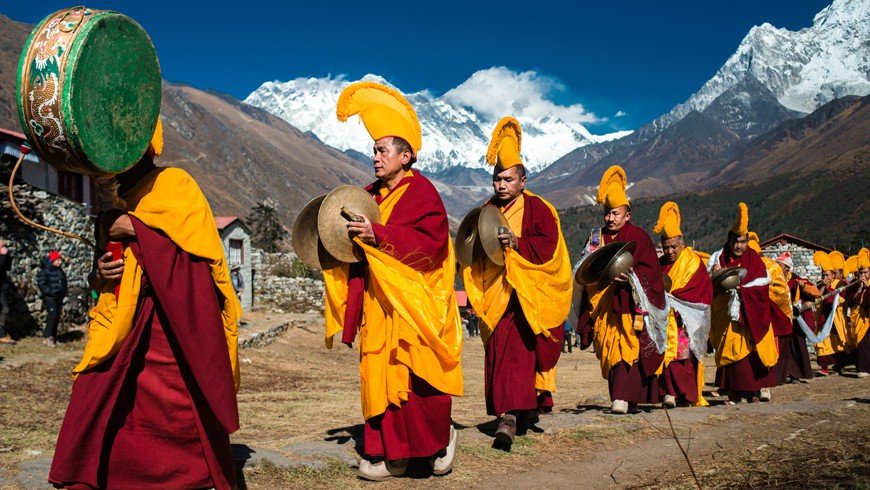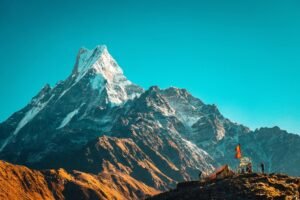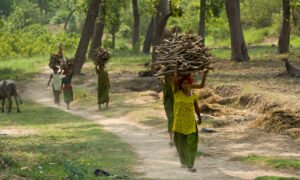The Himalayan region, stretching across five countries (Bhutan, India, Nepal, Pakistan, and China), is not only renowned for its stunning natural landscapes but also for its rich tapestry of cultures, traditions, and festivals. This region, often described as the “Roof of the World,” is home to a diverse array of ethnic groups, each with its unique customs and celebrations. From grand religious festivals to intimate local rituals, the cultural heritage of the Himalayas is vibrant and deeply rooted in history. This article explores the fascinating festivals and traditions that make the Himalayan region a cultural treasure trove.
The Spiritual Heart of the Himalayas
The Himalayas have long been considered a spiritual sanctuary, attracting pilgrims and seekers from around the world. The region’s cultural practices are heavily influenced by major religions such as Hinduism, Buddhism, and Islam, along with indigenous beliefs. This spiritual richness is reflected in the numerous festivals celebrated throughout the year, each with its distinct significance and rituals.
Hindu Festivals
Dashain
Dashain is the longest and most significant Hindu festival in Nepal, celebrated with great fervor by Nepalese communities worldwide. Spanning 15 days, Dashain commemorates the victory of the goddess Durga over the demon Mahishasura, symbolizing the triumph of good over evil. The festival involves various rituals, including animal sacrifices, family gatherings, and the exchange of blessings and gifts.The first nine days, known as Navaratri, are dedicated to worshipping the nine manifestations of Durga. On the tenth day, Vijaya Dashami, people receive tika (a mixture of rice, yogurt, and vermillion) and jamara (barley sprouts) from elders, symbolizing their blessings. Kite flying, swinging on traditional bamboo swings, and feasting are also integral parts of the celebrations.
Tihar
Following Dashain, Tihar, also known as the Festival of Lights, is another major Hindu festival in Nepal. It spans five days and honors various animals considered sacred in Hinduism, including crows, dogs, cows, and oxen. Each day of Tihar is dedicated to a different animal, with specific rituals and offerings.
The festival culminates with Bhai Tika, where sisters apply tika to their brothers’ foreheads and pray for their long life and prosperity. In return, brothers give gifts and promise to protect their sisters. Homes are decorated with oil lamps, candles, and colorful rangoli (designs made with colored powders) to welcome the goddess Laxmi, the deity of wealth and prosperity.
Buddhist Festivals
Losar
Losar, the Tibetan New Year, is the most significant festival for Tibetan Buddhists in the Himalayan region. Celebrated primarily in Tibet, Bhutan, Nepal, and parts of India (notably Ladakh, Sikkim, and Arunachal Pradesh), Losar marks the beginning of the lunar calendar and is a time for family reunions, feasting, and religious ceremonies.Preparations for Losar begin weeks in advance, with homes thoroughly cleaned to remove negative energies. The festival itself spans 15 days, with the first three days being the most important. On the first day, known as “Lama Losar,” offerings are made at monasteries, and religious ceremonies are held to seek blessings for the new year. The second day, “King’s Losar,” involves official ceremonies and community feasts. The third day, “Common Losar,” is when families come together to celebrate with traditional foods, dances, and music.
Buddha Jayanti
Buddha Jayanti, also known as Vesak, commemorates the birth, enlightenment, and death of Gautama Buddha. It is celebrated with great reverence in Nepal, Bhutan, and by Buddhist communities throughout the Himalayas. On this day, devotees visit monasteries and stupas, offering prayers, lighting butter lamps, and participating in various religious activities.
In Lumbini, Nepal, the birthplace of Buddha, the celebrations are particularly grand, attracting pilgrims from around the world. Monks and devotees engage in chanting, meditation, and processions, reflecting on the teachings of Buddha and promoting peace and compassion.
Indigenous and Local Festivals
Mani Rimdu
Mani Rimdu is a significant festival in the Everest region of Nepal, celebrated by the Sherpa community at the Tengboche Monastery. This 19-day festival, culminating in three days of public celebrations, marks the establishment of Buddhism in Tibet by the legendary guru Rinpoche (Padmasambhava).
The festival includes elaborate rituals, masked dances, and the creation of intricate sand mandalas. The dances, performed by monks in colorful costumes and masks, depict the victory of Buddhism over the ancient animistic Bon religion. The celebrations are both a religious ceremony and a community event, attracting locals and trekkers alike.
Archery Festivals in Bhutan
Archery is the national sport of Bhutan and an integral part of Bhutanese culture. Archery festivals and competitions are held throughout the year, often coinciding with local religious and cultural celebrations. These events are not only sports competitions but also social gatherings, where communities come together to celebrate, socialize, and enjoy traditional music and dance.
During the festivals, teams of archers compete with great skill and enthusiasm, aiming at small wooden targets placed 145 meters apart. The atmosphere is festive, with spectators cheering, singing, and performing traditional dances to encourage the participants. The competitions reflect Bhutan’s unique cultural identity and community spirit.
Islamic Festivals
Eid al-Fitr and Eid al-Adha
In the predominantly Muslim regions of the Indian Himalayas, such as Kashmir and Ladakh, Islamic festivals like Eid al-Fitr and Eid al-Adha are celebrated with great devotion. Eid al-Fitr marks the end of Ramadan, the holy month of fasting, while Eid al-Adha commemorates the willingness of Ibrahim (Abraham) to sacrifice his son as an act of obedience to God.
These festivals involve communal prayers at mosques, feasting, and the exchange of gifts. Families come together to celebrate, and special meals are prepared, including traditional dishes such as biryani, kebabs, and sweets. The sense of community and charity is emphasized, with donations and acts of kindness extended to the less fortunate.
Unique Traditions of the Himalayan People
Beyond the grand festivals, the daily lives of the Himalayan people are rich with unique traditions and practices that reflect their close relationship with nature and spirituality.
The Mani Stones and Prayer Flags
One of the most iconic symbols of the Himalayan region is the mani stone, inscribed with the mantra “Om Mani Padme Hum.” These stones are often found along trails, in villages, and near monasteries, serving as spiritual markers. Prayer flags, known as “lungta,” are another ubiquitous sight, fluttering in the wind and believed to carry prayers and blessings to all beings.
Polyandry in Remote Himalayan Villages
In some remote Himalayan villages, particularly in Nepal and parts of India, the practice of polyandry (a woman having multiple husbands) persists. This tradition, often driven by economic and social factors, aims to keep family land intact and provide economic stability. While less common today, it remains a fascinating aspect of the region’s cultural diversity.
The Living Goddess of Kathmandu
In the heart of Kathmandu, Nepal, resides the Kumari, a living goddess believed to be the incarnation of the Hindu goddess Taleju. Selected from the Newar community, the Kumari is a young girl who undergoes a rigorous selection process and lives in the Kumari Ghar, a palace in Durbar Square, until she reaches puberty.The Kumari is worshipped and revered, and her blessings are sought during various festivals, particularly during Indra Jatra, a major celebration in Kathmandu. The tradition of the Kumari is a unique blend of Hindu and Buddhist beliefs, highlighting the syncretic nature of Nepalese culture.
Snow Leopard Conservation Traditions
In the high altitudes of the Himalayas, the elusive snow leopard is considered a sacred animal by many indigenous communities. Traditional beliefs and practices play a crucial role in the conservation of this endangered species. For example, the Buddhist principle of compassion for all living beings discourages hunting and promotes coexistence with wildlife.Local communities, in collaboration with conservation organizations, have developed innovative approaches to protect snow leopards, such as predator-proof livestock pens and community-based tourism initiatives that provide economic incentives for conservation.
The Role of Monasteries and Temples
Monasteries and temples are the cultural and spiritual heart of Himalayan communities. They serve as centers for religious activities, education, and community gatherings.
The Monasteries of Ladakh
Ladakh, often referred to as “Little Tibet,” is home to some of the most impressive Buddhist monasteries in the Himalayas. Hemis Monastery, the largest and wealthiest in Ladakh, hosts the annual Hemis Festival, featuring masked dances and religious ceremonies.Thiksey Monastery, resembling the Potala Palace in Lhasa, offers stunning views of the Indus Valley and is known for its beautiful architecture and large statue of Maitreya Buddha. These monasteries are not only places of worship but also repositories of art, culture, and history.
The Temples of Uttarakhand
The Indian state of Uttarakhand, known as the “Land of the Gods,” is dotted with ancient temples and pilgrimage sites. The Char Dham Yatra, a pilgrimage to the four sacred shrines of Yamunotri, Gangotri, Kedarnath, and Badrinath, is a major religious journey for Hindus.Each of these temples has its unique significance and attracts thousands of devotees every year. The pilgrimage routes pass through some of the most scenic landscapes in the Himalayas, offering a spiritual journey amidst nature’s splendor.
Preserving Cultural Heritage in the Face of Modernity
While the Himalayan region retains much of its traditional charm, it is not immune to the pressures of modernization and globalization. Pres
erving cultural heritage in the face of these challenges is crucial to maintaining the region’s unique identity.
Sustainable Tourism
Tourism is a double-edged sword for the Himalayas. While it brings economic benefits and raises awareness about the region’s cultural heritage, it also poses risks of environmental degradation and cultural erosion. Promoting sustainable tourism practices, such as eco-friendly trekking, responsible wildlife tourism, and community-based tourism initiatives, can help mitigate these impacts.
Documentation and Revitalization
Efforts to document and revitalize traditional practices, languages, and art forms are essential for cultural preservation. Local governments, NGOs, and community organizations play a vital role in these initiatives, ensuring that future generations can continue to celebrate and cherish their heritage.
Education and Awareness
Raising awareness about the importance of cultural heritage among local communities and visitors is crucial. Education programs that incorporate traditional knowledge and values can foster a sense of pride and responsibility towards preserving cultural heritage.
The festivals and traditions of the Himalayan region offer a fascinating glimpse into the rich cultural tapestry of this awe-inspiring part of the world. From grand religious festivals that attract pilgrims from across the globe to unique local practices that reflect the intimate relationship between the Himalayan people and their environment, the cultural heritage of the Himalayas is both diverse and deeply rooted in history.
As the region continues to navigate the challenges of modernization and globalization, it is essential to preserve and celebrate this cultural richness. By promoting sustainable tourism, documenting and revitalizing traditional practices, and raising awareness about the importance of cultural heritage, we can ensure that the unique identity of the Himalayan region endures for generations to come.Immersing oneself in the festivals and traditions of the Himalayas is more than just a cultural experience; it is a journey into the heart and soul of one of the most spiritually and culturally vibrant regions in the world. Whether you are a traveler seeking adventure, a pilgrim in search of spiritual solace, or a cultural enthusiast eager to learn, the Himalayas offer a profound and enriching experience that is truly unparalleled.





